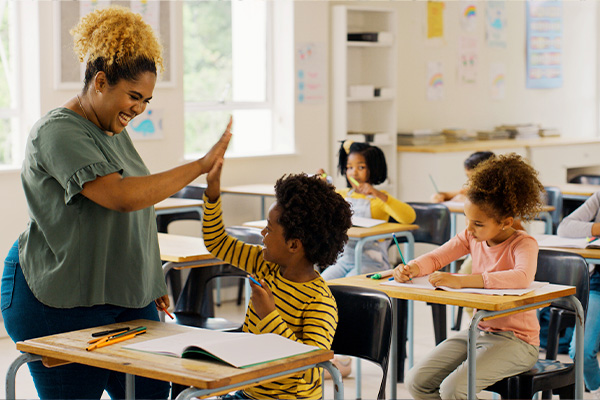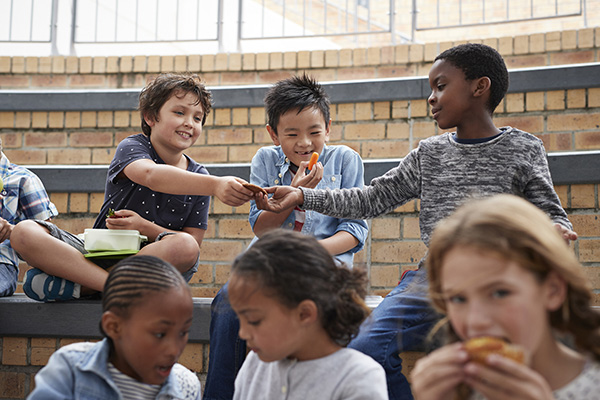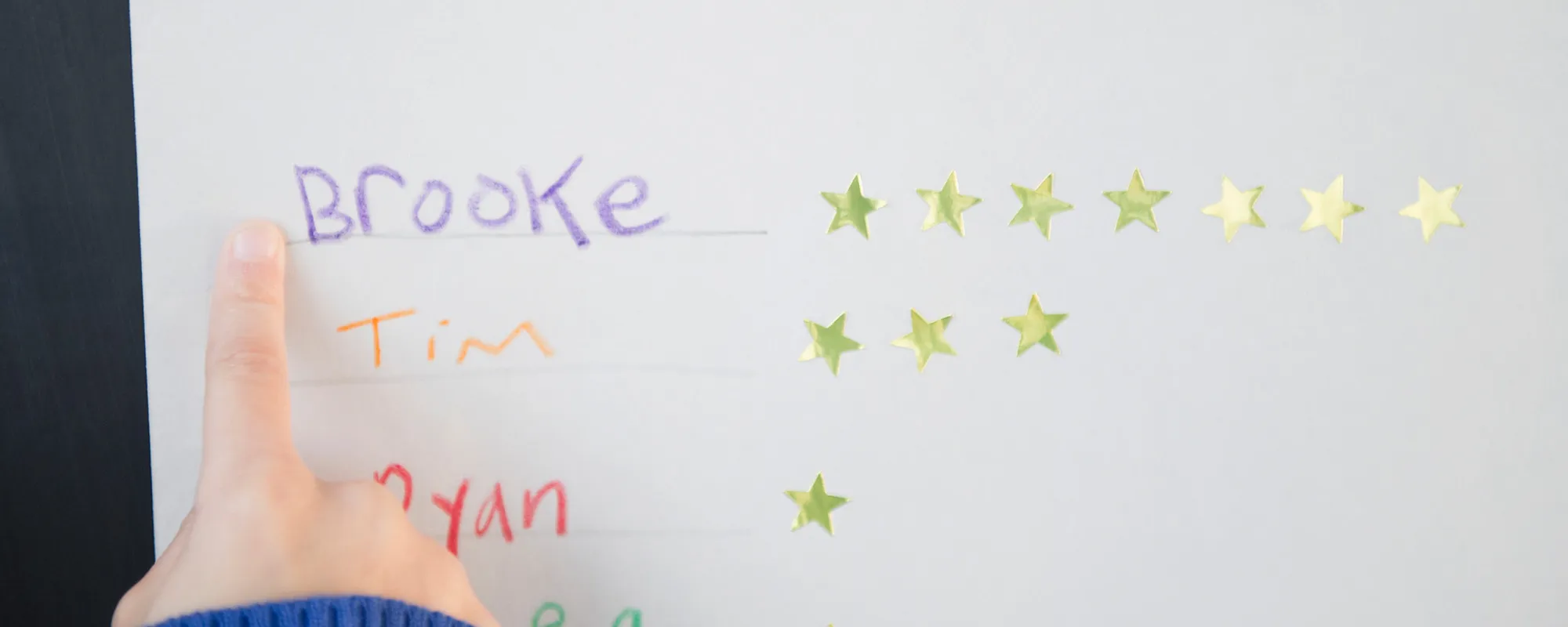May 12, 2022
Most teachers enter the field of education because they enjoy working with students and they love learning. But too often, student behavior—and addressing misbehavior—can seem to derail a teacher’s best efforts at doing the thing they love.
What if we could turn the question, “How do you manage student behavior issues in the classroom?” to, “Is it possible to prevent student behavior issues in the classroom?”
In this blog, I’ll answer both of those questions.
Why is prevention so important in classroom behavior management?
“An ounce of prevention is worth a pound of cure.”
When Benjamin Franklin coined this phrase in 1736, he wasn’t speaking about behavior tips for teachers. But the phrase still holds true in the 21st-century educational system when it comes to managing student behavior.
Just as eating right and exercising pay big health dividends in the long run, doing the hard work of prevention on the front end of classroom management can keep problems from occurring that later need to be fixed.
It’s true that preventing problems requires time and resources, but the alternative can be even more costly.
Responding to challenging student behavior with clear consequences—such as a trip to the principal’s office—may seem like an easy solution, but preventing those negative behaviors in the first place means students can remain in the classroom, learning and engaging with their peers.
Preventing issues related to behavior: 8 classroom management strategies
You may be convinced that prevention is preferable, but many teachers have tried different classroom management tactics without success. Rather than continuing with an approach that isn’t working, take a look at these strategies geared at preventing unfavorable behaviors before they start.
Knowing how to manage student behavior takes time, patience, and willingness to try different strategies.
#1: Know what to avoid
Sometimes, the best way to know how to approach an issue is to first identify actions to steer clear of. So take care to avoid the following:
- Power struggles. These rarely, if ever, produce the desired behavior from your students. Rather than resolving the problem, power struggles are likely to escalate them. When you feel the temptation to engage in a power struggle, take a step back, remain calm, and keep the conversation short and succinct.
- Requiring students to remain stationary for long periods. This is a sure way to invite unruly classroom behavior. According to a 2013 study of six California elementary schools, “Implementing classroom physical activity breaks can improve student physical activity during school and behavior in the classroom.”
- Public reprimands. These should also be avoided, especially in front of students’ peers. No doubt, there will be times when a student needs to be corrected. When those times come, pull the student aside or step outside of the room to privately address the inappropriate behavior.
#2: Establish a productive learning environment
The learning environment can be either a “make-it” or “break-it” scenario. Even as adults, we understand the difficulty of attempting to work or study in less-than-ideal surroundings. For children, the classroom environment can be key to their learning and behavior.
Teachers should pay careful attention to the following to create an environment ripe for learning and classroom behavior management:
- Consider the seating arrangement: Is the student facing the teacher? Does the seating arrangement invite unnecessary interaction with other students?
- Be sensitive to noise: Is the air conditioning unit making a distracting noise? Is the hubbub in the hallway making it difficult for a student to focus?
- Keep the student close to the teacher. Students who struggle with behavior issues can benefit from staying in close proximity to you.
- Finally, remove temptation by distancing students struggling with behavior issues from others who may be instigators.

#3: Create opportunities for more frequent positive feedback
We all seem to have a natural tendency to focus on the negative. But making a small and decisive change in this area can result in favorable dividends when it comes to a peaceful and enjoyable classroom.
Make it a goal to provide more positive feedback to students than negative feedback. A good ratio to strive for is 4:1—four positive comments for every one correction. Not only will classroom behavior improve, but the student/teacher relationship will have more of a chance to thrive.
#4: Address problem behavior immediately
A classroom is a busy place. Teachers perform a variety of activities throughout the day, including:
- Teaching lessons
- Answering students’ questions
- Keeping records; and
- Managing behavior
With so many demands, it can be hard to prioritize correcting behavior. And though it may seem the best option at the moment to finish the lesson, addressing problem behavior right away is a major step teachers can take to prevent more troubling student behavior later on.
Talking to students one-on-one in a supportive manner:
- Provides immediate feedback
- Keeps the situation at the forefront; and
- Helps the student to know how they can improve
In the end, it also helps to restore and improve the relationship between the student and teacher.
Supporting positive behavior
Discover resources from Renaissance to strengthen both academics and social-emotional behavior.
#5: Build positive relationships with your students
Often considered one of the most important steps for managing student behavior, building positive relationships will pay off in spades. Here are eight strategies for building relationships with your students:
- Learn every student’s name quickly and correctly at the start of the school year.
- Post students’ pictures and the work they produce.
- Allow show-and-tell to give an opportunity for students to share something important about themselves.
- Compliment your students on their academic achievements and positive character traits.
- Take the time to listen to your students when they want to share a part of their lives outside of school.
- Schedule regular one-on-one chats with students to check in on their emotional well-being.
- Make notes about each student’s likes and dislikes or personal information they’ve shared with you so that you can reference it when needed.
- Celebrate your students’ birthdays.
#6: Communicate with parents and caregivers
Beyond calling home when there’s an issue, teachers should make a point to share each student’s successes and milestones with caregivers. Every parent or guardian likes hearing positive feedback about their child and then sharing that feedback with their child.
Make a point to contact a different family every day to share some achievement, whether academic, social, or emotional. While it may seem like a lot of work at first, families who respect and support the teacher pass those feelings along to their child who, in turn, is more likely to behave for the teacher.
#7: Set clear expectations with a behavior management plan
Starting the school year with classroom rules and procedures is only effective if you take the time to explain specific expectations and why they matter. For example, if one of the rules is to “Always respect your classmates,” then you may need to give examples that clarify exactly what respect looks like to you.
Involve your students in creating a behavior plan that is realistic and that the students can all agree to follow. Giving your students some autonomy can help with addressing student behavior.
#8: Incorporate movement into the day
Sitting for hours on end is hard enough for adults—for kids, it can seem impossible. Plan a few different ways to get your students up and out of their seats throughout the day, such as:
- Flexible seating options, including balance balls, bean bag chairs, or wobble stools
- Brain breaks, such as playing trivia games or “Simon says”
- Active learning activities
- Take work outside when the weather is favorable
- 5-minute stretch at students’ desks
Not only are you resetting students’ brains, but you’re letting them get their “wiggles” out, which can really help with managing student behavior before problems arise.
The importance of knowing what your students experience at school and at home
Most teachers and school administrators agree that preventing issues that lead to negative student behaviors is more desirable than the alternative. But many educators struggle to find a way to manage classroom behavior in a way that results in happy and fulfilled students and teachers.
Having a comprehensive assessment solution that helps to identify the underlying motivations behind challenging behavior can help. There is also a significant benefit in learning about your students’ school life and home life.
How so?
Without a doubt, teachers understand the importance of knowing their students. Knowing students well allows teachers to:
- Accentuate students’ strengths
- Understand students’ struggles and weaknesses; and
- Adjust the learning style to fit students’ needs
But beyond academic success, knowing your students personally helps to foster a strong student/teacher relationship that is based on understanding, compassion, and respect.
Knowing what students experience both at school and home can also give a teacher valuable information regarding students’ behavior. It can not only help a teacher to understand why a student is behaving in a certain way, but it can also help a teacher know how to address it with care and sensitivity.

What to identify about your students’ school life
A child’s school day is full of activity. With numerous students in a classroom, a teacher may not be able to witness every interaction.
For instance, perhaps a student has a falling out with her best friend during recess and returns to the classroom forlorn or angry. Without knowing about the recess interaction, a teacher may be at a loss to understand the sudden change in the student’s behavior.
As much as a teacher is able, paying careful attention to what students experience throughout their school day can give insightful clues to student behavior—and avenues to know how to address them.
When considering what a student’s school life involves, think about:
- Friends
- Interactions with other teachers and school staff
- The lunchroom environment
- Whether the school setting is supportive
What to identify about your students’ home life
Without knowing about a student’s home life, it can be very difficult to provide appropriate support.
As adults, teachers know how outside events and stressors can affect them, and the same is true with students—positive and negative influences and struggles in the home environment can clearly influence student behavior.
But unlike adults, students don’t have the experience and maturity to know how to adjust. That’s where knowledge of a student’s home life is extremely valuable.
What kind of information is helpful in increasing teacher awareness? Here are some suggestions:
- What parental figures are in the home?
- Is a student’s home life supportive or combative?
- Is the student home alone for long periods of time?
- Are there other children/siblings in the home? What are the sibling dynamics?
- What is the student’s cultural and socio-economic background?
How you can learn more about your students’ home life
Getting to know students and their home life doesn’t have to be complicated or involve surveys that have a price tag attached to them. If teachers or administrators are currently surveying families, they are already one step ahead.
The following simple ideas can give teachers insight into a student’s home life that can then translate into creative intervention (and prevention) in the classroom:
- Give a writing prompt like “What I did last night” or “My favorite activity to do with my family”
- Ask students to list their top 5 (or 10) favorite things to do outside of school
- Talk and listen to students in one-on-one conversations
Though it isn’t always possible or practical for all teachers, visiting a student’s home or family can provide helpful information to give a better understanding of a student’s challenges and needs.
Learn more about managing student behavior with tools from Renaissance
Renaissance offers resources to equip educators to know how to best manage student behavior and establish best practices through:
- Social-emotional assessment and progress monitoring
- Dyslexia screening
- Reports and data visualization for both academics and social-emotional behavior
- And more
Renaissance equips educators with the best tools to measure student progress and determine the most effective instructional or intervention strategies.
Perhaps you searched out this article because you’re wondering how to manage student behavior through prevention. Renaissance can help. Our data-driven solutions for educators support the whole child.
Connect with an expert today to learn more.

